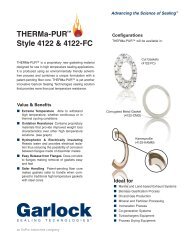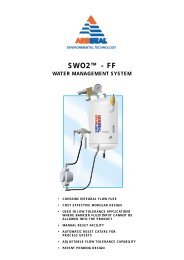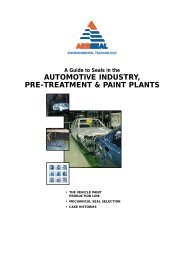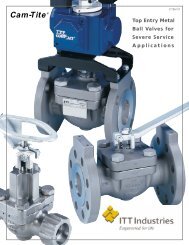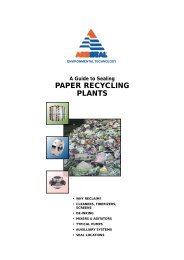expansion joints - AR Thomson Group
expansion joints - AR Thomson Group
expansion joints - AR Thomson Group
Create successful ePaper yourself
Turn your PDF publications into a flip-book with our unique Google optimized e-Paper software.
Standard Design (cont’d)<br />
The maximum elongation setting “E” shown in Figure<br />
5 is based on each <strong>expansion</strong> joint's design and will vary<br />
for different manufacturers. Refer to Table I for typical<br />
elongation requirements for single or multiple arch <strong>expansion</strong><br />
<strong>joints</strong>.<br />
Overcompression of <strong>expansion</strong> <strong>joints</strong> is controlled by<br />
installing compression sleeves over the tie rods. The<br />
compression sleeves are usually made from commercially<br />
available black iron pipe. The length of the pipe sleeve<br />
should be such that the <strong>expansion</strong> joint cannot be compressed<br />
beyond its maximum allowable capabilities. This<br />
allowable movement is the setting “C” of Figure 5 and is<br />
based on design requirements stated by the <strong>expansion</strong><br />
joint manufacturer. Table I lists typical compression<br />
movements for single or multiple arch <strong>expansion</strong> <strong>joints</strong>.<br />
Note: The control unit settings E and C are based on<br />
the <strong>expansion</strong> joint installed at neutral manufactured<br />
lendth “FF” with pipe flange alignment of<br />
±1/8" (0.125mm) maximum.<br />
The triangular plates for control units are usually<br />
fabricated from ASTM A-36 plates or other high-strength<br />
plate materials. The plates are drilled with three holes,<br />
two of which are used for bolting the plate to the pipe<br />
Special Design<br />
Figure 6 shows an <strong>expansion</strong> joint with an assembly<br />
of control unit components with spherical washers. This<br />
special design is suitable for applications where greater<br />
control of piping movements is required.<br />
As shown in Figure 6, the movement of the pipe<br />
flanges is restricted to transverse deflection only. This is<br />
made possible by the spherical washers on both sides of<br />
the triangular plates. By tightening the spherical washers<br />
against the plate at both ends of the tie rods, compression<br />
and elongation of the <strong>expansion</strong> joint is eliminated.<br />
The elimination of axial movement may be required to<br />
control stress in the pipeline or equipment.<br />
If, in another application, axial movement of the pipe<br />
flanges must be provided, then the hex nuts are adjusted<br />
to allow the <strong>expansion</strong> joint to compress and elongate as<br />
required. The inner hex nuts are set to control compression<br />
of the <strong>expansion</strong> joint. The outer hex nuts are set to<br />
control elongation of the <strong>expansion</strong> joint. Once the hex<br />
nuts are set, the threads of the tie rods are “staked” and<br />
the control units function in the same manner as the control<br />
units of Figure 5.<br />
flange. The third hole is for the tie rod which connects<br />
the plate on each end of the <strong>expansion</strong> joint. To dampen<br />
noise and vibration, rubber washers are used<br />
between the plate and the rod. The rubber washers are<br />
typically made of a 1/4" (0.25mm) thick 80 shore A<br />
durometer rubber.<br />
To evenly distribute the load from the hex nuts<br />
(ASTM 194-2H) against the rubber washer, steel washers<br />
are used, as shown in Figure 5. The steel washers<br />
are US Standard washers with an I.D. and O.D. to<br />
match the dimensions of the rubber washers. Once the<br />
control units are installed and set, it is critical that the<br />
setting is not altered during the service life of the joint.<br />
Vibration of the piping system can often loosen and<br />
gradually turn the hex nuts, changing the critical setting<br />
of the control units. To prevent the turning of the hex<br />
nuts, the threads of the tie rods are “staked” on each<br />
side of the hex nut.<br />
Notes: 1. Control units do not protect the <strong>expansion</strong><br />
<strong>joints</strong> against lateral offsets. Piping must be<br />
anchored and supported.<br />
2. Do not use control units with non-metallic<br />
flanges which do not have sufficient strength.<br />
Steel Spherical Washers<br />
Control Rods<br />
Hex Nuts<br />
Control Rod Plate<br />
Retaining Ring<br />
Expansion Joint<br />
Pipe Flange<br />
Figure 6<br />
Expansion Joint with assembly/installation of control unit<br />
components with spherical washers.<br />
7




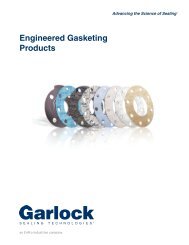
![VCS Flange Gasket [1.03 MB] - AR Thomson Group](https://img.yumpu.com/12044617/1/190x245/vcs-flange-gasket-103-mb-ar-thomson-group.jpg?quality=85)

![PGE Flange Gasket Product Brochure [1.04 MB] - AR Thomson Group](https://img.yumpu.com/12044595/1/190x245/pge-flange-gasket-product-brochure-104-mb-ar-thomson-group.jpg?quality=85)
